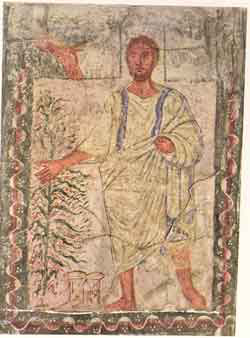Rupture and repair
The story of Joseph, recounted in twelve chapters of the book of Genesis (37, 39 - 49), is, on the one hand, the natural continuation of the patriarchal narratives of Abraham, Isaac and Jacob. But on the other hand, post-biblical Jewish tradition does not consider Joseph one of the patriarchs. Joseph is an extraordinary character: He is handsome, wise, successful and beloved…but he is also hated, oppressed, vengeful and narcissistic. His life is a series of descents and ascents. He is not the recipient of divine revelations, unlike his forebears, but instead he has dreams: he is the dreamer par excellence and he is the interpreter of dreams, indeed he is "this master of dreams," as his brothers call him disparagingly (Genesis 37:19).
Joseph is one of Jacob's sons, but as opposed to all the others, no tribe bears his name, but rather two tribes are named for his sons Ephraim and Manasseh, while Joseph's name became an epithet of the Kingdom of Israel. In post-biblical tradition, Joseph is also one of the Ushpezin, the mystical guests in every Sukkah. Thus Joseph is both similar to and different from his predecessors. But the most decisive connection between the story of Joseph and the preceding material in Genesis lies in the motif of sibling rivalry: As in the preceding stories, hostility reigns between brothers and here, too, the favored son becomes estranged from his doting parents.
Why is Joseph Jacob's favored son? Apparently because of Jacob's love for the departed and lamented Rachel, Joseph's mother. So great is Jacob's love of Joseph that after his disappearance, only his younger brother, Benjamin, is considered by Jacob as his son—see the striking words of Genesis 42:38
My son will not go down [to Egypt] with you,
for his brother is dead and only he remains!
Thus we return here to the biblical staples of preference and jealousy—although this time, finally, there is also reconciliation.
Biblical Joseph became an important character in Judaism's daughter religions, Christianity and Islam. Christian interpretation compares Joseph to Jesus in several manners, especially as a saintly figure who, although rejected by his contemporaries, transcended his suffering.
As for Islam, an entire chapter of the Quran is dedicated to Joseph; it contains both paraphrases of the biblical account of his life and midrashic materials whose origins are in Judaism and Christianity. During the Middle Ages, the Sufis, Muslim mystics, wrote several works on the love of Joseph and Zuleika, as Potiphar's wife is named. These works were extremely popular and served as the basis and inspiration for paintings of Joseph by Muslims artists.
These various approaches to the story and character of Joseph express the differences between the three religions, while the very interest in Joseph is an indication of their common denominators. We will now look at examples of the artwork that has been created around Joseph's fascinating character, with special emphasis on how artists have treated alienation in Jacob's family and the resolution of this problem.
Joseph in Art
The episodes in the story of Joseph most frequently treated by artists are:
•Joseph's dreams (Genesis 37)
•His abduction and sale (Genesis 37)
•The announcement of his death to Jacob (Genesis 37)
•The story of Potiphar's wife (Genesis 39)
•Pharaoh's dreams and Joseph's rise to power (Genesis 41)
•Joseph's meeting with his brothers and their reconciliation (Genesis 42ff.)
•Jacob's arrival in Egypt and his meeting with Joseph (Genesis 46)
•The blessing of Ephraim and Manasseh (Genesis 48)
In the following discussion, we will ask how different artists express their conceptions regarding the story of Joseph by way of their portrayal of :
•Joseph's character, his manner and his appearance
•Joseph's and Pharaoh's dreams
•Joseph's coat
•The environment (the lands of Canaan and Egypt)
•Potiphar's wife
•Joseph's brothers
•Jacob
•And especially the reparation of the rupture in this family
Joseph's Dreams
Genesis 37 contains two main episodes: Joseph's dreams and his sale into slavery. The first episode is the background of the second: it is the first event in Joseph's life story recounted and it provides an opportunity to describe concretely and factually the tainted relationship between Joseph and his brothers. The brothers' hatred of Joseph stems, as is well-known, from their father's undisguised favoring of Joseph; this hatred is exacerbated by Joseph's recounting of his dreams and results in his sale into Egyptian bondage. But already before the dreams, Joseph's preferential status is stressed by the special coat given him by Jacob.
Joseph's Coat
Although Joseph's coat is mentioned only in Genesis 37, it has become his personal icon and appears in various guises in portrayals of other episodes of his life, by artists throughout history and across cultures. As we shall see, this garment and the ways in which artists treated it are expressions of their attitudes toward Joseph himself. What is this special coat?
Outside of its appearance in Genesis 37, such a coat is mentioned only in II Samuel 13:18 as the garb of royal princesses. The word ketonet, meaning simply a tunic, is found in Exodus 28, in the description of the priestly garments. The special character of Joseph's coat is explained in several ways by the following Midrash:
And he made him a ketonet pasim - Resh Lakish in the name of R. Eleazar b. Azariah: A person must not make distinction among his children, for on account of the ketonet pasim which our father Jacob made for Joseph, They hated him.
pasim - because it went as far as his wrists (pas yad)
Another explanation of pasim - it was very thin and light and could be tucked in at the wrists.
Pasim - so called because they cast lots (hepisu) for it, to tell who should carry the cloak to their father. The lot fell on Judah.
Pasim - its letters are an acronym for the story of Joseph's troubles: Potiphar, traders (sokharim), Ishmaelites, Midianites.
Another explanation, Resh Lakish in the name of R. Eleazar b. Azariah: Come and see the words of God. He is terrible in his deeds toward the children of men. He turned the sea into dry land (Ps. 66:5). Why did they hate him? Because he split the sea open for them. The word pasim yields the letters of the phrase pasyam, 'the sea in strips'.
And as if this were not enough, the great medieval commentator Abraham Ibn Ezra, in his comment on Genesis 37:3, adds an explanation based, in accordance with his method, on linguistic analysis:
Pasim - an embroidered tunic. Pasim is similar to pas yada (=
the wrist, Daniel 5:5) in Aramaic.
Some of these suggestions attempt to explain the unusual word literally, especially using the citation from the book of Daniel. These explanations conclude in general that Joseph's coat had long sleeves, apparently based on the assumption that such garments were unusual in the Biblical Age. On the same basis, Ibn Ezra concludes that the tunic was embroidered or that it was made of pieces of multi-colored cloth. But none of the older definitions are similar to the usage in modern Hebrew of pasim as stripes!
Finally, in the painting below from an Egyptian tomb of the 14th century BCE, matching Joseph's cultural background, messengers of Syrian kings are portrayed offering tribute to the king of Egypt; they are dressed in colorful tunics with long sleeves. Such garments accord with some of the explanations given above. While we are left in some doubt regarding this coat, it is undoubtedly a sign of Joseph's favored position in the family, and therefore makes him a target.

Dreaming
While in his drawing below, Rembrandt does not pay particular attention to the coat, Joseph is indeed the proud center of attention, lecturing (as if from a podium, set off by a curtain) before and opposite his entire family.
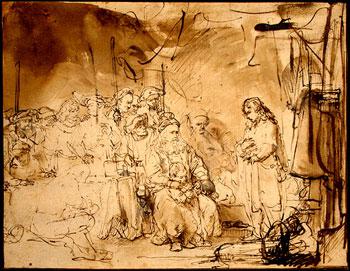
At the head of the family, sits the concerned Jacob, with little Benjamin standing at his feet, uninterested except in his own childish world. Behind them spreads the large, sketchy patch of Joseph's brothers, with a dark cloud hovering above them. And indeed, in the Bible itself the gang of brothers is often a collective character. But here, although it is difficult to identify specific figures, we easily perceive individual faces that variously express curiosity, disdain, mockery, perplexity and anger.
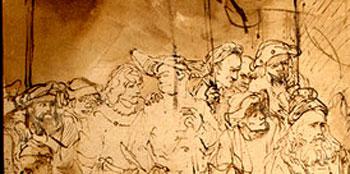
Likewise in Shalom of Safed's portrayal of the same scene, Joseph stands opposite his family, but here, instead of Rembrandt's highly dramatic depiction, we encounter something like comics.
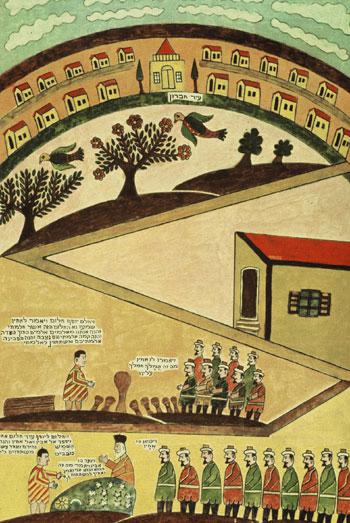
Shalom of Safed, Joseph recounts his dreams, 1960's
Rolly polly young Joseph is dressed in a stripped coat and a little yarmulke, while his bearded brothers stand in single file wearing alternating green and red coats and tarbushes. As for Jacob, while he too is dressed in a monochrome garment, his beard is white and his hat that of a dignified elder of the Ottoman period.
In addition to the story's cast, Shalom depicts the dreams themselves, as well as incorporating quotations from the biblical text. With regard to the second dream, note that the "bubble" of the sun, moon and stars is on the ground before Joseph, as if the heavenly bodies are bowing to him.
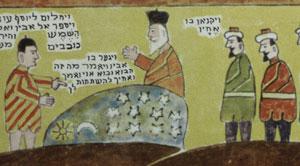
Despite the labeling of this scene with the notice that Jacob scolded Joseph, the figures themselves display no emotions. Thus, we may conclude that while Rembrandt expresses the interpersonal tension through the physical appearance of the characters, Shalom intended mainly to memorialize this foundational event in Jewish history.
The Sale of Joseph
As mentioned above, Joseph is an important figure in the Quran, and even more so in later Muslim tales, which focus on Joseph's super-human beauty, reflecting his saintly character, on the great suffering that he had to overcome in the course of his life and on the intense love of Potiphar's wife for him, to which we will return below.
According to the biblical account, some time after Joseph's dreaming, Jacob sent his older sons to pasture his flocks in the vicinity of Shechem, far from the family's home in Hebron, where Joseph remained; later, Jacob sent Joseph "to see how [his] brothers' and the sheep were faring". But in the Quran's version of this story, it was the brothers who proposed that Joseph join them, planning in advance to do him harm.

Mir Ali, Joseph and brothers, 16th century
In a rare depiction of this scene by the Persian artist Mir Ali, Jacob's sons bid farewell to their father and his sister, who raised Joseph after the death of his mother, and carry off Joseph on their shoulders. According to the version of the story recounted in the Romance of Yusuf and Zuleikha by the 15th century Sufi poet Jami, Jacob's sons hoodwinked their father into allowing them to abduct Joseph by pretending to be loving and caring brothers—as long as they were in sight.
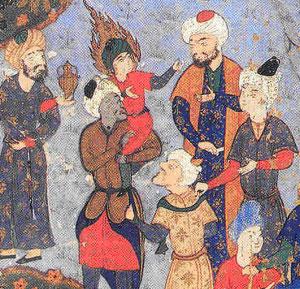
While the fiery halos of Jacob and Joseph identify them as saints, the faces and gestures of the brothers reveal their hypocrisy and their evil intent. Unlike Christian iconography, Joseph wears no special coat, since in Muslim literary and artistic tradition, the tunic was exchanged for a belt.
Many renditions of the sale of Joseph into slavery by his brothers have been created by Jewish, Christian and Muslim artists throughout the ages. While Muslim paintings deal mainly with Joseph's rescue from the pit and his descent to Egypt in the company of the Ishmaelites, Christian artists tend to focus on Joseph's sale by his brothers, as a prefiguration of Judas' betrayal of Jesus to the Romans for 30 shekels of silver and on Joseph's ascent from the pit as a prefiguration of Jesus' resurrection. In modern times, this episode has continued to fascinate artists of many sorts—for example, in his trilogy on the life of Joseph, Nobel prize winning author Thomas Mann dedicated over 50 pages to the retelling of the sale into slavery.
In the painting below, from a small group of paintings dealing with biblical subjects painted in 1900 by the Hungarian artist Karoly Ferenczy, Joseph stands at the center of a mixed crowd of his brothers and Ishmaelites.

In the background can be seen a desolate vista, offering no shelter; this landscape is an externalization of Joseph's suffering and the alienation that characterizes the sale of the young man by his own brothers.

Joseph appears half-naked, in shock and in pain; around his waist is a colored garment (apparently the remains of his famous coat—but a memory of his former status) and he his being held by two dark, primitive looking figures. His brothers are not portrayed as evil, unlike the pictures of Rembrandt and Mir Ali; but rather they stand awkwardly and confused, as if they want nothing other than to have done with the matter and to go their way. Ferenczy's personal interpretation of the sale of Joseph focuses, then, on suffering and human indifference to it, while the world of nature reflects and echoes the emotions of the individual.
Diego Velasquez' painting of 1630 depicts the moment at which the brothers inform Jacob of Joseph’s “death”, as told in Genesis 37:31-34:
31 So they took Joseph’s tunic, and slaughtered a male goat and dipped the tunic in the blood; 32 and they sent the varicolored tunic and brought it to their father and said, “We found this; please examine it to see whether it is your son’s tunic or not.” 33 Then he examined it and said, “It is my son’s tunic. A wild beast has devoured him; Joseph has surely been torn to pieces!” 34 So Jacob tore his clothes, and put sackcloth on his loins and mourned for his son many days.
In Velasquez' version, the episode seems to occur within a 17th century Spanish home, with a tiled floor, divided by a carpet into Jacob’s domain and that of his sons.
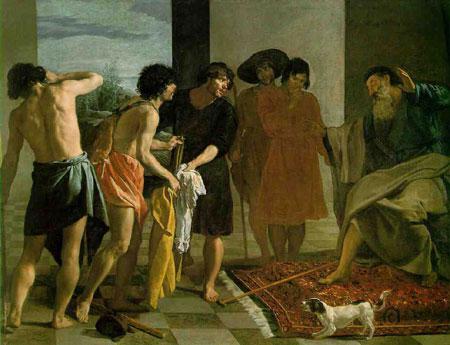
While Jacob is not at the painting’s center, his figure attracts the viewer’s eye because of his striking pose, raising his arms and beginning to rise as he begins to fall on having heard the tragic news. The carpet slipping under his feet and his fallen walking stick symbolize his collapsing world.
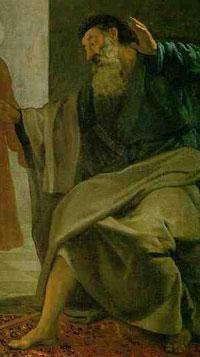
Here again, as in Rembrandt’s drawing of the dreams, we see a variety of expressions on the faces of Joseph’s brothers—sorrow, confusion, clowning, etc.
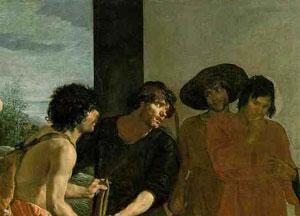
But exactly in the geometrical center of Velasquez’s painting are two extraordinary details: a barking dog and the fallen walking stick that are pointing at the bloody coat, expressing suspicion and announcing to us the truth that Jacob cannot see.
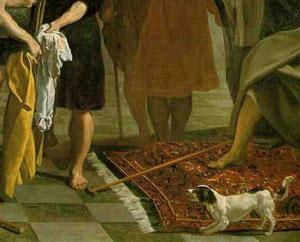
A similar visual/exegetical ploy, perhaps expressing the hand of God, appears in the English painter Ford Maddox Brown’s rendition of the same scene from 1876.
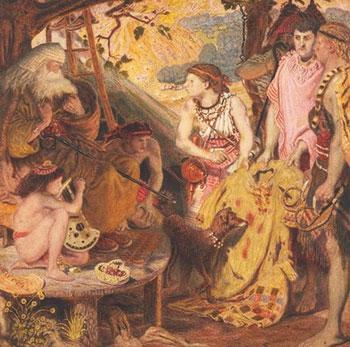
The difference between the role of the dog in the two paintings is that while in Brown’s version, the animal quietly sniffs the coat, expressing only for the viewer its instinctive knowledge of the truth, Velasquez’ dog barks in protest against the brothers’ lie and tries unsuccessfully to warn Jacob.
Joseph in the House of Potiphar
Another incident in the story of Joseph that has received much attention from the artists of various cultures is the episode of Joseph and Potiphar’s wife (Genesis 39). In the biblical account, after reporting Joseph’s miraculous rise to prominence from his lowly status as a foreign slave, an apparent non sequitur informs us that “Joseph was comely and handsome”, in the very words used earlier to describe his mother, Rachel (Genesis 29:17). Only on further reading do we discover that this physical beauty is what brought Joseph to the attention of his Egyptian master’s wife, who tries to seduce him. This attempt and its rebuff are described in a dialogue in verses 7-9:
7 It came about after these events that his master’s wife looked
with desire at Joseph, and she said, “Lie with me.”
8 But he refused and said to his master’s wife, “Behold, with me
here, my master does not concern himself with anything in the
house, and he has put all that he owns in my charge.
9 There is no one greater in this house than I, and he has
withheld nothing from me except you, because you are his wife.
How then could I do this great evil and sin against God?”
While Potiphar’s wife’s physical appearance is never described, we readily perceive her licentious character and unbridled passions in these first verses, by way of her blunt speech. In the continuation, she also turns out to be a manipulative liar, skilled in rhetoric. Joseph, in contrast, is portrayed as honest and loyal to his master and to his God. Note that despite Joseph’s former way with words, his refusal in the verses cited above are his last ones in this chapter and he does not defend himself against his mistress’s false accusations—a veritable saint:
He was oppressed and he was afflicted,
Yet he did not open His mouth (Isaiah 53:7)
In accordance with this behavior, Christian commentary identified Joseph as a prefiguration of Jesus and Potiphar’s wife as a satanic creature, and therefore compared our episode to the meeting between Jesus and Satan.
Potiphar’s wife was also identified as a symbol of the Jews, who falsely accused Jesus. But the main Christian understanding of the story of Potiphar’s wife stresses Joseph’s refusal of her wanton sexual advances as a model of pious behavior.
An unknown Flemish painter of the 16th century focuses in the painting below on Joseph’s flight from the arms of Potiphar’s wife, illustrating in the background her appeal to her husband and Joseph being led to prison.
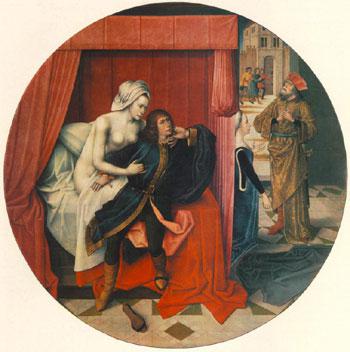
In the main vignette, the terrified Joseph is fully and elegantly clothed, while Potiphar’s naked wife tries to envelope him in her arms.
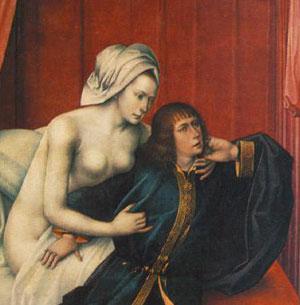
Because of the color of her skin and the shape of her, she seems to be a kind of succubus or a siren who captures unsuspecting men or even a serpent. Observation of Joseph’s pose reveals that with one hand he tries to free himself from the clutches of Potiphar’s wife, but his other hand rests on her thigh—is this in fact an expression of ambivalence toward her? Alternatively one can understand Joseph’s pose as forming the sign of the Cross.
As mentioned above, Muslim tradition gives Potiphar’s wife the name Zuleikha and tells of her tragic love of Joseph, inspired by his beauty and his saintly character. In her despair due to Joseph’s chastity, she invites her friends to her home in order display Joseph’s angelic features:
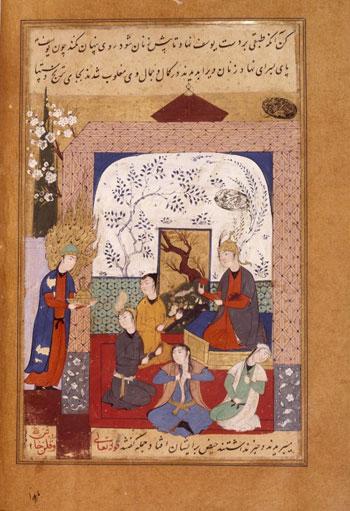
The Persian style and miniature dimensions of this manuscript painting (in this case, a version of Qisas al Anbiya by the Persian poet Nishaburri), did not allow detailing of facial expressions. Instead, the characters and the background were painted according to stylized artistic conventions meant to express a mixture of calm and passion.
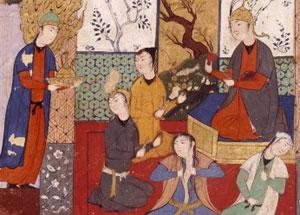
On the left, Joseph, crowned with a halo, enters the banquet room in the classic pose of a servant. Opposite him, seated upon a dais, Zuleikha sits holding fruit and a knife. Her friends, sitting below her, swoon at Joseph’s beauty (see Quran 12:21; Tanhuma Vayeshev 5; Sefer Hayashar Vayeshev). In the Quranic interpretative tradition, Potiphar’s wife is neither a demon nor a wanton but rather an especially emotional woman. Therefore, it is not strange that in later Muslim literature, her love of Joseph became a model of platonic-divine love.
Comparison of the Muslim painting to the Christian portrayal shown above reveals another striking difference between them. In the Christian rendition, Joseph’s relationship with Potiphar’s wife is clandestine, allowing the eruption of lust and passion. In the Muslim environment, their meeting is in public, so that such outbursts are avoided.
The Reunion in Egypt and the Conciliation
Joseph’s years in prison and his plan to store up Egypt’s crops during the seven good years brought him to the heights of power, while in far off Canaan his family suffered from the famine of the seven lean years. As a result, Joseph’s brothers came to Egypt to purchase food (Genesis 42), and found themselves standing before the unknown Egyptian lord:
6 Now Joseph was the ruler over the land; he was the one who sold to all the people of the land. And Joseph’s brothers came and bowed down to him with their faces to the ground. 7 When Joseph saw his brothers he recognized them, but he disguised himself to them and spoke to them harshly. And he said to them, “Where have you come from?” And they said, “From the land of Canaan, to buy food.”
8 But Joseph had recognized his brothers, although they did not recognize him. 9 Joseph remembered the dreams which he had about them….
Several of the phrases in these verses indicate Joseph’s mixed emotions, especially the words “he recognized them but disguised himself (literally, ‘made himself foreign’) to them,” that in Hebrew sound similar, but in fact are virtual antonyms. Some midrashim explain this psychological state as divinely caused:
Because the tribes came down to Egypt and he saw them, he pitied them as it is written, “Joseph recognized…”. And he turned away from them… - at once, an angel descended and appeared to Joseph in the guise of a man and said to him, “You pity these scoundrels? Do you not remember what suffering they caused you?: they cast you into the pit and sold you four times. Thus he began speaking to Joseph and at once, he disguised himself to them. Midrash Aggadat Bereshit 73
While this Midrash presents Joseph’s unsympathetic behavior as the will of God, one might understood it rather as Joseph's own ambivalence.
In the two paintings below, from 14th century Europe, these mixed emotions are expressed visually through Joseph’s hands and face.
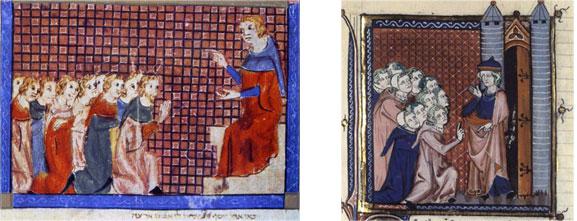
Sarajevo Haggadah, Bible historiale,
Joseph and his brothers, ca. 1350 Joseph and brothers,
early 14th century
In both the Bible Historiale created in Christian France (on the right) and the Sarajevo Haggadah of Jewish Spain, Joseph gestures upward and downward, as an expression of the tension between the principles of justice and mercy or divine fiat and human behavior, etc. Likewise, Joseph’s face expresses the difficulty inherent in his meeting with his brothers and his emotional turmoil. As for the brothers, in the Sarajevo Haggadah, all kneel, and in a gesture of abject appeal. In contrast, in the Bible Historiale, while the lead brother kneels, the group as a whole stands at the same height as Joseph—may we see in this rendition an expression of a confrontational approach similar to that of the Midrash?
Joseph’s emotional turmoil increases after the brothers are released from their three-day arrest. Joseph is hard put to maintain his strict pose when they express their guilt feelings regarding his long ago sale in response to Simeon’s continued incarceration:
18 Now Joseph said to them on the third day, “Do this and live, for I fear God: 19 if you are honest men, let one of your brothers be confined in your prison; but as for the rest of you, go, carry grain for the famine of your households, 20 and bring your youngest brother to me, so your words may be verified, and you will not die.” And they did so. 21 Then they said to one another, “Truly we are guilty concerning our brother, because we saw the distress of his soul when he pleaded with us, yet we would not listen; therefore this distress has come upon us.” 22 Reuben answered them, saying, “Did I not tell you, ‘Do not sin against the boy’; and you would not listen? Now comes the reckoning for his blood.” 23 They did not know, however, that Joseph understood, for there was an interpreter between them. 24 He turned away from them and wept.
William Blake depicted this dramatic episode in a painting in which Joseph and his brothers experience their anguish separately, but in the space.
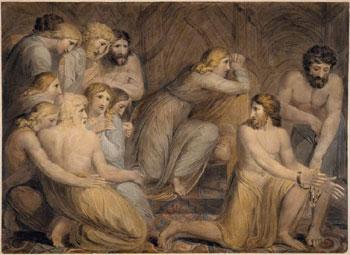
In contrast, in the 6th century Vienna Genesis, an illuminated manuscript of the Septuagint, Joseph stands behind a door, in an adjoining room—apparently in a conflation of the accounts in Genesis 42 and 43:
29 As he lifted his eyes and saw his brother Benjamin, his mother’s son, he said, “Is this your youngest brother, of whom you spoke to me?” And he said, “May God be gracious to you, my son.” 30 Joseph hurried out for he was deeply stirred over his brother, and he sought a place to weep; and he entered his chamber and wept there.
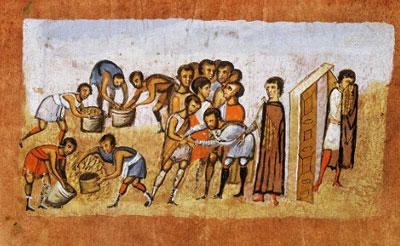
In this painting, Joseph also orders the imprisonment of Simeon, who is separated from his terrified brothers. On the left, Joseph’s servants are loading the brothers’ packs with grain. Thus, the painting moderates the harshness of Simeon’s arrest by juxtaposing them with acts of Joseph’s kindness. The same aim is achieved in a Midrash that reports that Simeon was only imprisoned by Joseph as a ruse: after the departure of Jacob’s sons, Joseph treated Simeon with great hospitality.
Then he turned away and wept - R. Haggai in the name of R.
Isaac: In their presence he said, Arrest him! But when they left,
he provided him with food and drink and gave him a bath and
anointed him. Bereshit Rabba 91:8
But the brothers have not seen the end of their trials at the hand of their unrecognized brother: In the end, they will have endured hard words, accusations, waiting, Simeon made a hostage, the planting of silver in their packs, a strange banquet and finally Benjamin’s life threatened. One may read Joseph as vengeful, exploiting his position for the purpose of paying his brothers back for the suffering he endured years before. Such appears to be the reading of Salvador Dali, who stresses Joseph's cruelty toward his brothers and describes him as a despot, inured to their pain.
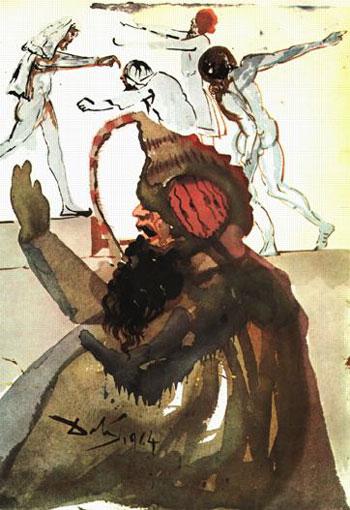
Salvador Dali, Joseph and his brothers in Egypt, 1964-67
But one may alternatively see Joseph's behavior toward his brothers as an attempt to understand the significance of his dreams as a spoiled child and of the will of God. Or perhaps Joseph has consciously created a situation in which his brothers once more have an opportunity to be rid of their father's favorite (now, Benjamin). But this time, led by Judah, they change their behavior. When Joseph orders Benjamin to be enslaved, Judah delivers an impassioned speech, recounting the family's gloomy history and offers himself as a hostage instead of Benjamin, in order to prevent further suffering by their father, Jacob. Joseph's response to Judah's words is remarkably dramatic:
1 Then Joseph could not control himself before all those who stood by him, and he cried, “Have everyone go out from me.” So there was no man with him when Joseph made himself known to his brothers. 2 He wept so loudly that the Egyptians heard it, and the household of Pharaoh heard of it. 3 Then Joseph said to his brothers, “I am Joseph! Is my father still alive?” But his brothers could not answer him, for they were shocked by his presence. (Genesis 45: 1 - 3)
The two paintings below describe Joseph's "revelation" to his brothers. But there are significant differences between their treatments of the scene.
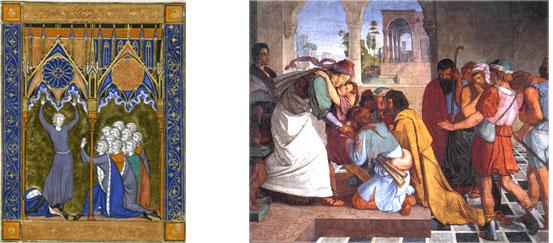
First of all, the painting on the left, from a Paris Psalter, centers on the moment of the cry: I am Joseph!
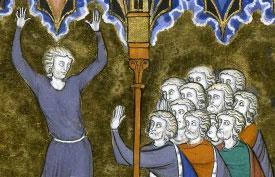
Joseph's revelation of his identity is expressed visually in the fall of his cape (a reflex of his famous coat) and the raising of his hands upward. This extension portrays Joseph as superior in height (i.e., status) to his brothers, who kneel before him in abject obeisance. But at the same time, Joseph is exposed and his similarity to his brothers is revealed, since Judah, standing at the head of the group, is dressed identically to Joseph. Note also that Judah's hands break through the boundary between the brothers' and Joseph's sections of the painting, as if they are "breaking the ice" between them.
Peter Cornelius, for his part, relates mainly to verse 14 -15 in his portrayal of the revelation scene:
Then he fell on his brother Benjamin’s neck and wept, and Benjamin wept on his neck. He kissed all his brothers and wept on them, and afterward his brothers talked with him.
But he also illustrates verse 3:
But his brothers could not answer him, for they were shocked at his presence.
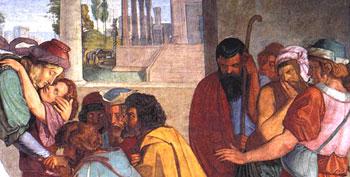
Joseph's brothers are divided into two distinct groups in this picture: those who stand apart from Joseph, not having yet recovered from the shock of Joseph's revelation; and those who approach him, looking at him with expressions of fear and submission.
Likewise, in Midrashim on this episode, there are varying views on the characters and intentions of Joseph and his brothers.
Then Joseph could not control himself - R. Hama bar Hanina said: Joseph did not act properly, for if one of the brothers had kicked him, he would have died forthwith.
R. Samuel bar Nahmani said: He acted properly. He knew the truly righteous character of his brothers. He thought, God forbid, my brothers are not suspect of intent to murder. Bereshit Rabba 93:9
According to this text, opinion is divided regarding the mental state of the brothers: Were they still hostile to Joseph or had they undergone a process of reconciliation?
Jacob and Joseph
Between the verses illustrated in the last two paintings, Joseph explains that his sale into slavery was the will of God, intended to save the entire family and insure their continued existence. Only one thing remains to accomplish God's will: that his father, Jacob, be brought to Egypt.
And indeed, the brothers return to their home and announce to Jacob that Joseph is alive. On Jacob's way to meet Joseph in Egypt, God speaks to the patriarch (who, unlike his son, is prone to direct divine revelations) and promises Jacob that he will be buried in the land of Canaan.
The wording of the unexpected reunion of Joseph and Jacob seems to contain hidden significance:
Joseph prepared his chariot and went up to Goshen to meet his father Israel; as soon as he appeared before him, he fell on his neck and wept on his neck a long time. Then Israel said to Joseph, “Now let me die, since I have seen your face, that you are still alive.” Genesis 46:29-30
Writers of Midrash asked themselves: What is the meaning of the word "appeared," so fraught with biblical associations? Who fell on the neck of whom and who wept? And why is the word ôd, 'more, again' used repeatedly here?
All agree that "appeared" indicates that Jacob did not at first recognize Joseph and that the ambiguous wording of these verses reflects uncertainty about the relative status of Joseph and Jacob. Thomas Mann's account of the meeting is a modern Midrash rooted in abundant classical sources and reflecting the story's tensions:
And although Benjamin and the others at first tried to prevent [Jacob], he rose from the litter with their help in labored stateliness, limping from the hip more than ever, for he purposely exaggerated his lameness. Alone he went up to the other, who hastened his steps to shorten the distance between them. The man's smiling lips shaped the word "Father" and he held his arms open before him. But Jacob had his own stretched out like a blind man groping; his hands moved as though beckoning, yet partly too as though to protect himself. For as they came close he did not allow Joseph to fall on his neck and hide his face on his shoulder as his son would have done. Instead he peered and searched with his tired old eyes, his head laid back and sideways; peered long and urgently into the Egyptian's face with love and sorrow painted on his own, and did not recognize his son.
In the mosaic decorating the walls of Florence's 13th- 14th century Baptistery, there seems to be no indication of theses Midrashic passions.
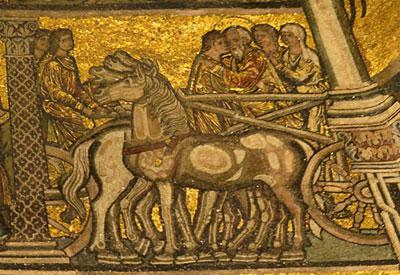
Meeting of Jacob and Joseph, 13th - 14th century
However, examination of the central place of the horses in this scene (unmentioned in the biblical text) reveals that they are a medium to visual the hidden tension between love and power: Joseph's horses, their heads hidden, are bowing before Jacob's horses, whose heads are lifted. It is Joseph who has left his chariot in order to greet his father, who stands in his cart; in other words, the Patriarch Jacob's status is greater than that of Joseph, the ruler of Egypt. While the family has indeed joined Joseph in Egypt, Joseph has also been reabsorbed into his family and, as portrayed in the mosaic, has resumed his role of son of Jacob. Thus both the Midrash and the artwork read the "happy ending" of the Joseph narrative as still fraught with contention, which cannot be entirely annihilated, but only restrained.
For additional images on this subject see TALI Visual Midrash



